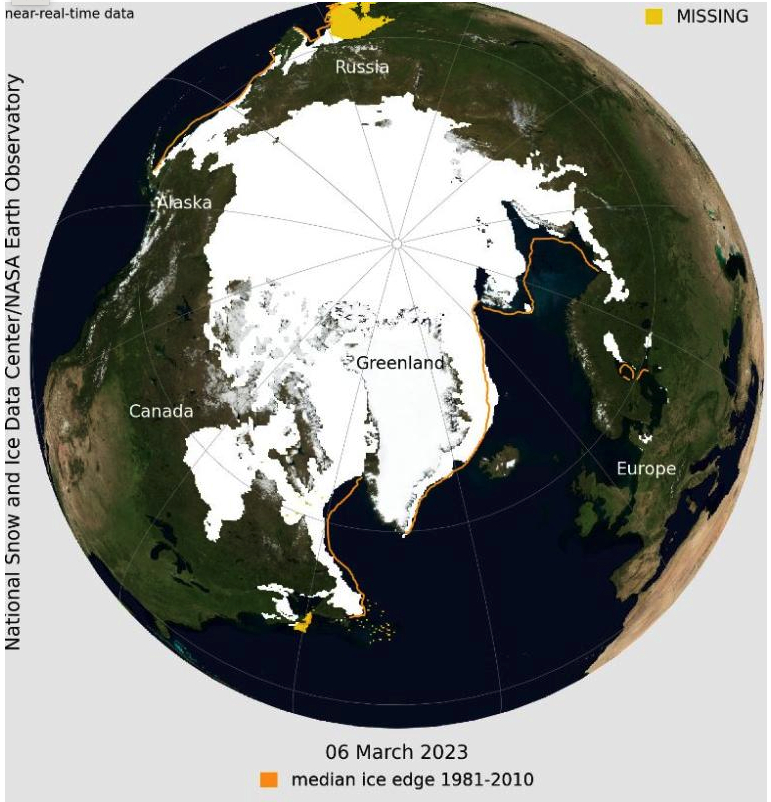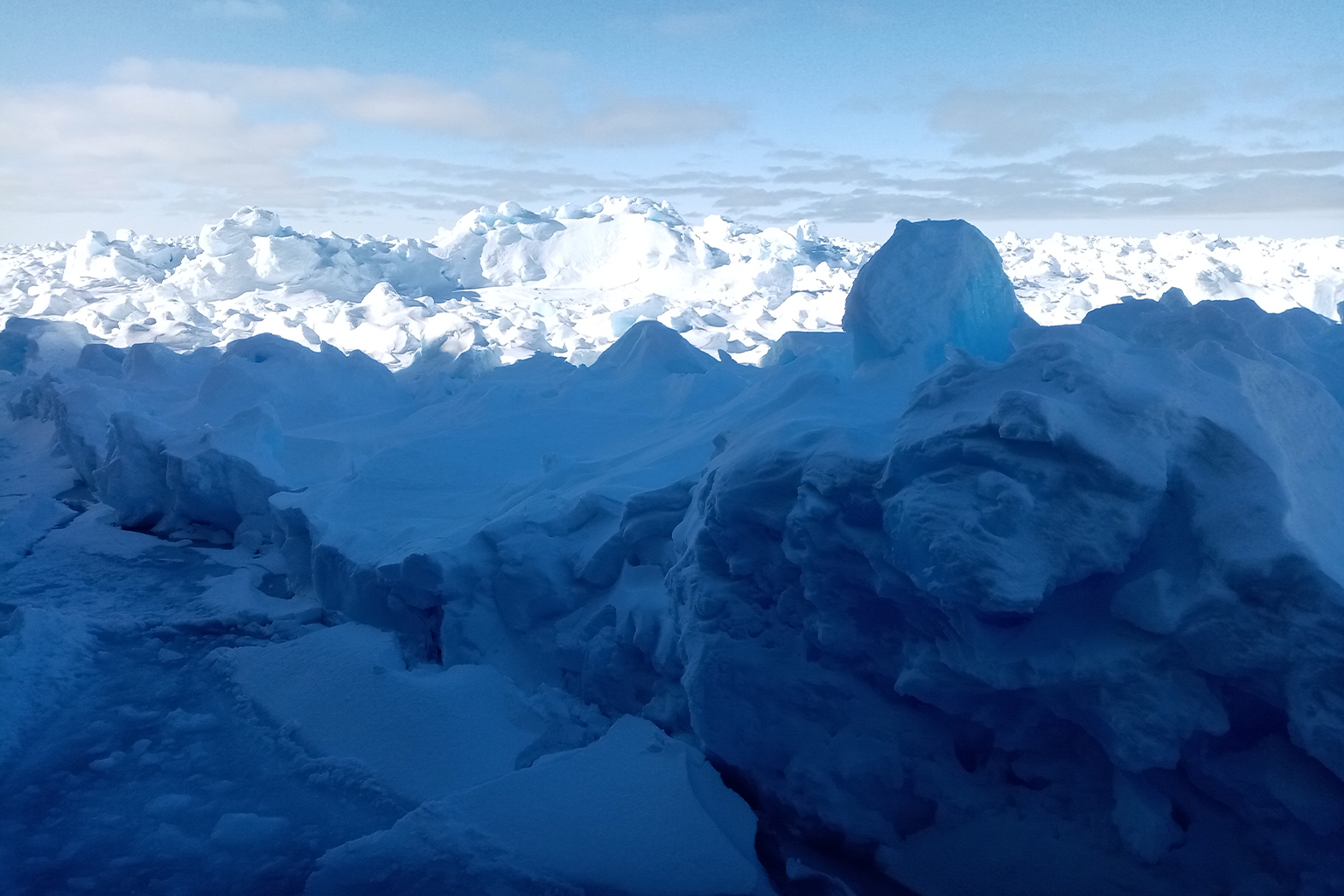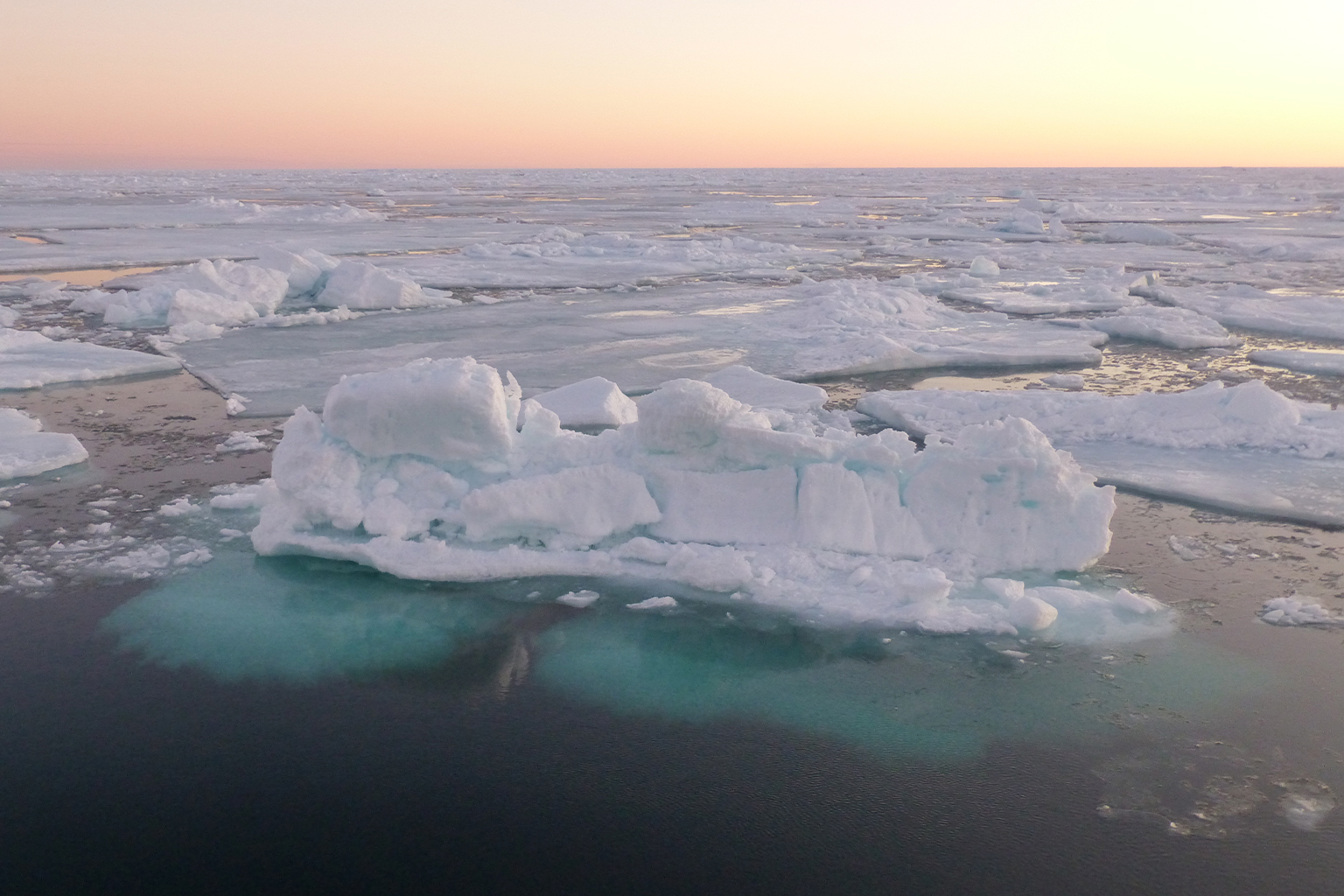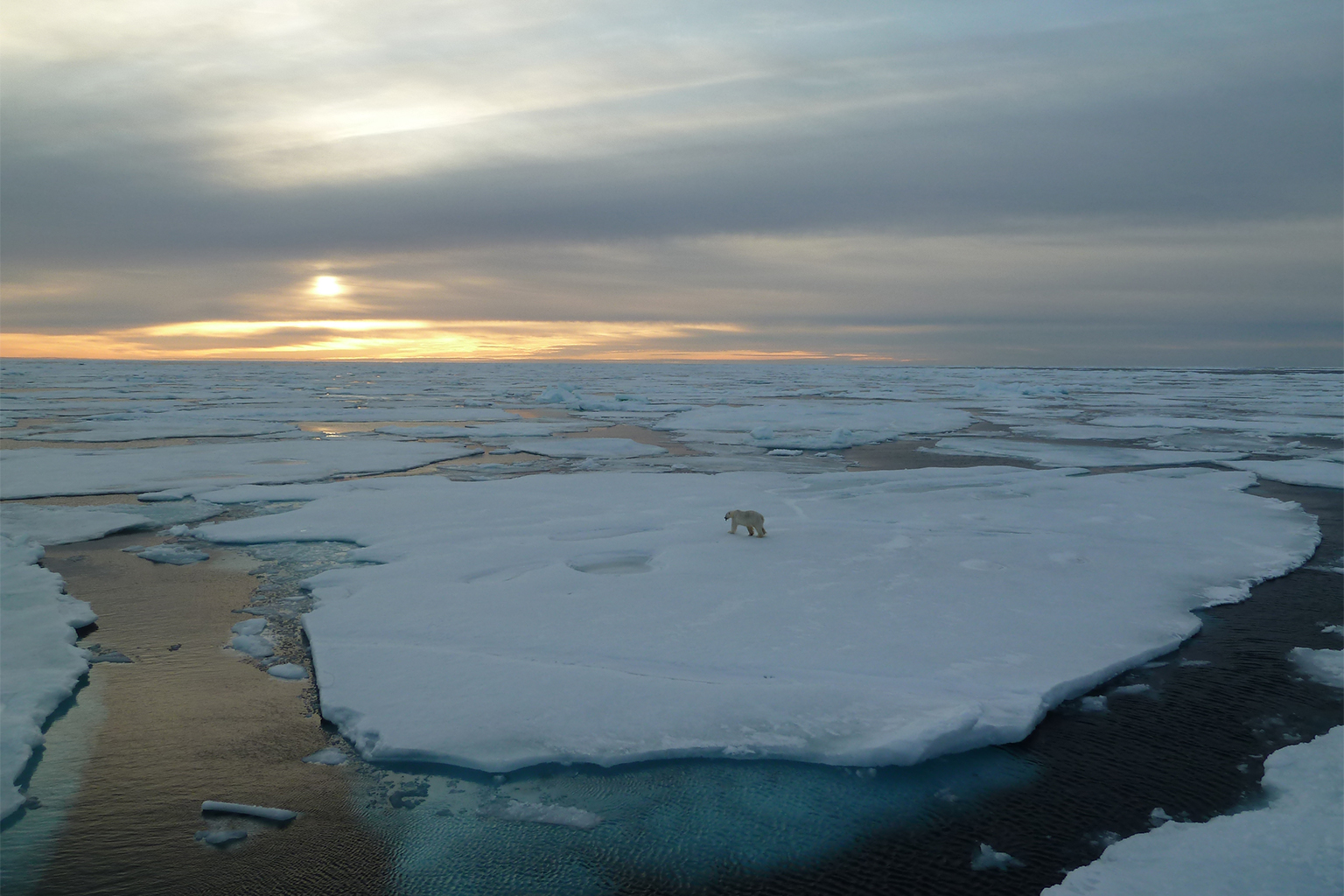- Arctic sea ice extent has reached its winter maximum extent for 2023 at 14.62 million sq. km., the fifth lowest on record. Combined with this year’s unprecedentedly small Antarctic sea ice summer minimum extent, global sea ice coverage reached a record low in January.
- Arctic sea ice is not only receding, but also seriously thinning. New research has found that a huge melt in 2007 and associated ocean warming kicked off a “regime shift” to thinner, younger, more mobile and transient ice that may be “irreversible.”
- A big reason why Arctic sea ice is declining even in the frigid polar winter is that atmospheric rivers, which carry warmth and rainfall like the deluges seen in California recently, are surging up from the south and penetrating the Arctic more often.
As Arctic sea ice reached a total winter maximum coverage that is again far below average, research has revealed how this ice is vulnerable to extreme weather arriving from more southerly parts of the globe — and how it might never recover.
Arctic sea ice, which expands through the fall and winter, reached an annual maximum extent of 14.62 million square kilometers (5.64 million square miles) on March 6, according to the National Snow and Ice Data Center (NSIDC). That means Arctic sea ice is starting the summer melt season more than a million square kilometers below average. The maximum, which came almost a week earlier than normal, is the fifth-lowest in the 45-year satellite record.
Antarctic sea ice extent has been in an even sorrier state, setting a record melt season low in February for the second year in a row, in what may be a sign that global warming will soon impact that polar system just as it’s been impacting Arctic sea ice. The combined sea ice extent around both poles hit a record low in January. While ice reflects most solar radiation, open water absorbs it, accelerating global warming in what is known as the ice-albedo feedback.
With warmer El Niño conditions expected to return later this year, significantly raising global temperature, the north polar ice cap could break its own record for lowest extent this fall. But it’s impossible to make any predictions, since highly variable summer weather patterns tend to have the biggest impact on sea ice melt, said NSIDC director Mark Serreze.

“We know that the minimum will be far below the climatological average this September, you can bet the house on that,” Serreze said. “But the issue is where it sits in the record book, and we don’t know.”
The largest decline during this month’s maximum was in the Barents Sea, where fingers of open water stretched to the north of Novaya Zemlya and of Svalbard, halfway between continental Europe and the north pole. That’s a few hundred miles beyond the 1981-2010 average ice edge and illustrates the “Atlantification” of the Arctic: More warm water is flowing north into the Fram Strait and the Barents Sea, Serreze said.
“The oceans are warming, there’s no doubt,” he said. “That would suggest that heat transport to the Arctic is increasing.”
2007 marked a ‘regime shift’ in ice thickness
Arctic sea ice is shrinking not only in extent but also in thickness. Multiyear ice, which doesn’t melt out in the summer and can fatten up to 4 meters (13 feet) or more, has lost a third of its winter volume in less than two decades, researchers found last year.
Much of that decrease is because ice is spending less time thickening in the Arctic before it flows south to melt, according a study published in Nature this month. A sudden drop in sea ice coverage in 2007, which beat the previous record low by a stunning 24% and prompted Scientific American to declare that “the north pole is melting,” also ushered in a “regime shift” in ice thickness, the new report said.
Most sea ice forms in the waters north of Alaska and Siberia, which have often been called the “ice factories” of the Arctic. From there, it’s slowly carried across the Arctic by the Transpolar Drift Current, which the explorer Fridtjof Nansen attempted to ride to the north pole in 1893. The ice then funnels through the Fram Strait east of Greenland, just as Nansen’s ice-bound ship Fram did in 1896, and into the north Atlantic, where it melts.

Since 1990, a string of underwater sonar moorings in the Fram Strait have been measuring the thickness of sea ice passing overhead. When Hiroshi Sumata of the Norwegian Polar Institute and his co-authors on the Nature study began analyzing this data, they expected to find that sea ice thickness was decreasing gradually. Sometimes, however, climate processes can change in leaps and bounds.
“We found that the decline of the thick ice type was not a gradual process, but a sudden and distinct change that occurred around 2007,” Sumata said.
A major melt event in 2005, and the dramatic drop in sea ice extent in 2007, left open water in the “ice factories” north of Alaska and Siberia that began absorbing more of the sun’s warmth in an ice-albedo feedback. Finding itself in hot water, the ice was never able to recover: It became more vulnerable to summer melt and less able to grow back in the winter. The average thickness of all but the youngest ice passing through the Fram Strait decreased from 2.7 meters to 1.7 meters (5.6 feet) after 2007.
Ice also didn’t stick around as long in the high Arctic. Thinner ice is not as well linked together and has shallower ridges or “keels” on its underside. As a result, winds and intense storms can more easily push it across the Arctic Ocean and south to its death in the Atlantic. In the Siberian sector in particular, average residence time of sea ice floes declined from 15 months to six months after 2007, indicating that most of them were no longer surviving the annual summer melt period to become thick multiyear ice. Once all multiyear sea ice is gone, the Arctic Ocean will be completely open in the summer, a grim milestone scientists say could come as soon as 2035.
The post-2007 shift to a regime of younger, thinner ice may be good news for entities like Russian oil and gas companies, who are trying to increase shipments along the Northern Sea Route to buyers in Asia. But it’s bad news for much of the rest of the world, since open water in the Arctic will help raise ocean and atmospheric temperatures globally.
“The north and south pole is something like a radiator of the Earth, the air conditioning system of the Earth,” Sumata said. “The situation we observed indicates the air conditioner is not working well.”
The shift in ice floe residence time “suggests an irreversible” change in ice thickness, the study found. Sumata was wary of calling this a “tipping point” like those that scientists have warned are imminent, such as the collapse of the Greenland ice sheet. But even if we rapidly reign in CO2 emissions, sea ice “is unlikely to revert the change at least until 2100,” he said.


Atmospheric rivers bring more warmth to the Arctic
Drastic melts like the ones in 2007 and 2012 have caused a strong downward trend in summer ice extent. But why has average sea ice coverage also been decreasing in winter, when it should be expanding under air temperatures that are still typically well below freezing?
A major reason is that atmospheric rivers have been bringing more warmth from lower latitudes into the Arctic, according to a February study in Nature Climate Change.
Atmospheric rivers are plumes of moisture in the sky that can transport water vapor equivalent to two or three times the flow of the Mississippi River. When they make landfall, they can cause torrential downpours of rain or snow like those seen in California in recent weeks.
Atmospheric rivers are much less common in the Arctic than in the mid-latitudes. But with climate models and satellite imagery, Pengfei Zhang of Penn State University and co-authors found that in the past four decades, atmospheric rivers have been penetrating the Arctic more frequently. In particular, the average time when atmospheric rivers are present in the section of the Arctic between 20 and 90 degrees East, which includes the Barents and Kara seas, has increased from 10 days to almost 11 days annually.
These rivers in the sky brought moisture far from the south. Since water vapor is a powerful greenhouse gas, atmospheric rivers trap heat over the sea ice. The rain released when their moisture condenses in the cool Arctic air also contributes to sea ice melting.

The researchers observed that wherever atmospheric rivers appeared in winter, sea ice stopped growing and often began to recede, as if a giant hair dryer had been aimed at it. In total, atmospheric rivers can explain more than a third of the total sea ice decline in winter months, the researchers found.
“I didn’t expect that,” Zhang said. “I did have an anticipation there should be a contribution, but we didn’t know how much.… [W]hen I got the results I can remember that I was excited, it’s new.”
These results are yet another example of how phenomena in one part of the globe can affect the climate in a totally different area through what’s known as a “teleconnection.” Last year, researchers discovered that Arctic sea ice loss could increase the frequency of strong El Niños and that increased evaporation from the Arctic Ocean was causing more snowfall in northern Eurasia.
In the case of atmospheric rivers, warmth arriving in the Arctic from the sub-tropics can melt sea ice. In one event in 2017, an atmospheric river stretched all the way from waters off the coast of Portugal to the Kara Sea north of Siberia.
“In the [global] climate system everything is connected to each other,” Zhang said.
The study results also indicate human complicity in what’s happening in the Arctic. By running climate models, the researchers determined that 68% of the increase in Arctic atmospheric rivers can be attributed to anthropogenic warming.
“The frequency is driven by human induced warming,” Zhang said. “We have the responsibility to make some efforts to cut emissions.”
Banner image: A polar bear surveys its icy Arctic surroundings. Image by Paul A. Dodd courtesy of the Norwegian Polar Institute.
Citations:
Hiroshi Sumata, Laura de Steur, Dmitry V. Divine, Mats A. Granskog & Sebastian Gerland. March, 2023. Regime shift in Arctic Ocean sea ice thickness. Nature.
Pengfei Zhang, Gang Chen, Mingfang Ting, L. Ruby Leung, Bin Guan & Laifang Li. February, 2023. More frequent atmospheric rivers slow the seasonal recovery of Arctic sea ice. Nature Climate Change.
FEEDBACK: Use this form to send a message to the author of this post. If you want to post a public comment, you can do that at the bottom of the page.
Melting ice created the perfect storm for a rapidly acidifying Arctic Ocean
